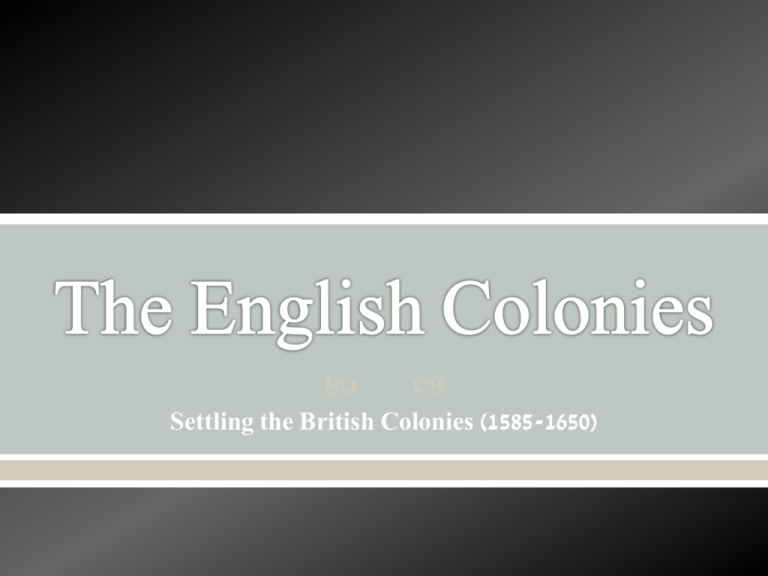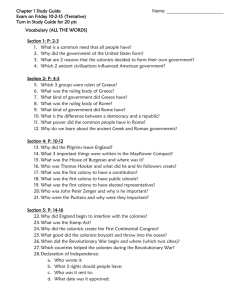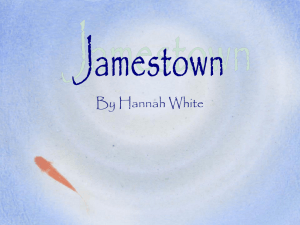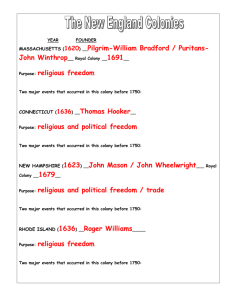The English Colonies - Metcalfe County Schools
advertisement

Settling the British Colonies (1585-1650) o Instrumental in the establishment of the Roanoke colony in the 1580s o First settled in 1585 as a base for pirate ships o Poor relations with the native population o Found abandoned in 1590 o o o Settled in 1607 First “successful” English colony Organized by the Virginia Company of London o Many settlers fell ill from disease o “Gentlemen” refused to do work o Not prepared to survive on their own • Relied on the local Powhatan Indians for food John Smith o Captured by Chief Powhatan & may have been saved by his daughter, Pocahontas o Negotiated with the Powhatan to obtain access to more food o Implemented a “no work, no food” policy in the colony o Returned to England in 1609 o Tobacco saved the colony from financial disaster o John Rolfe developed a new strain of tobacco that flourished in Virginia • • Created a labor shortage Resulted in the introduction of the Headright System: • Gave land to anyone who would pay the transportation costs of an indentured servant Led to the arrival of the first African slaves The Mayflower o Passengers included 102 men, women, & children • Made up of both “saints” & “strangers” o Arrived in New England in November 1620 • First landed in Cape Cod, then Provincetown, & finally Plymouth near the site of an abandoned Indian village o While on board, 41 Pilgrim leaders signed the Mayflower Compact The Mayflower Compact o Declared their support for King James I o Created a government to establish rules for the colony o Was an important step in colonial selfgovernment o o Nearly half died of exposure & disease during their first Winter Survived for a number of reasons: • • Strong leadership – William Bradford Help of Native Americans Squanto – served as an interpreter, taught the Pilgrims to grow corn & squash Massasoit – Wampanoag leader who signed a treaty of friendship with the Pilgrims o o Founded in 1630 Elected John Winthrop as governor o Advocated that the Puritans establish a “city upon a hill” as an example to all people of what a godly community could be o o o Governed by the General Court who then elected the governor Voting was restricted to church members Led to laws to protect authority & family values • Required church attendance & prohibited drunkenness, card playing, public kissing, etc. • Often punished with public shame & humiliation Roger Williams o o o o Called for the separation of church & state Declared that the colonists had no legal right to own land Banished in 1635 Moved to “Providence” & started his own colony o Purchased the land from the native populations & returned to England & received a charter from the Crown o Rhode Island became the 1st colony to practice religious toleration Anne Hutchinson o o Challenged the authority of the ministers Put on trial in 1637 • One critic commented “You have stepped out of your place; you [would] have rather been a husband than a wife, a preacher than a hearer, & a magistrate than a subject.” o Banished in 1638 • Went with her family & followers to an island south of Providence near present-day Portsmouth, RI o In 1633, a group from Plymouth settled in the Connecticut River Valley o Then in 1636, Thomas Hooker led about 100 Puritans from Massachusetts Bay to Connecticut o In 1639, he helped to draft the Fundamental Orders of Connecticut, a series of laws that provided for a government like that of Massachusetts • Key feature: Gave all free men the right to vote for their leaders o Tension developed between Pequots & the colonists as the English expanded into Connecticut o Pequots attacked English town of Wethersfield following a raid on one of their villages o Colonists from MA & CT attacked the Pequot Village in Mystic About 400 died as the village was burned o Ended Pequot resistance to English expansion o Native populations drop dramatically o o o o o From about 125,000 in 1625 to 10,000 in 1675 English settlement continued to expand Wild animals were replaced by domesticated ones Led to another series of conflicts in the 1670s o Named after Metacom, son of Massasoit o Formed an alliance against the English o Attacked more than 50 English settlements o Led to English retaliation o English burned native villages & destroyed stores of food o o One of the bloodiest & costliest wars in American history o o Helped by their own native alliances with groups such as the Mohawks 1.5% of the colonists, as well as 15% of the Native American population died Effectively ended Native American resistance in New England o Charles II granted land south of Virginia to 8 supporters in 1663 • Given the title of Lord Proprietors • Able to exercise their authority with virtual independence Background Settlement in the area began in 1670 o • • Many of its early settlers came from colonies in the Caribbean Learned to grow rice Search for a Labor Force o Indentured Servants o African Slaves • • • • Slaves for life Had knowledge of rice cultivation Immune to malaria & yellow fever Led to a black majority in South Carolina by the 1710s o Founded in 1732 & named for King George II o Created as a buffer between South Carolina & Spanish Florida Background o A group of trustees was charged with ruling the colony in its early years • • • • One trustee, James Oglethorpe, was key to the colony’s early history Hoped the colony could serve as a haven for debtors who could leave jail if they agreed to relocate in Georgia Prohibited slavery & alcohol Limited landholdings to 500 acres Early History o Ultimately, the population remained small & early goals were not reached • o By 1750, slavery had been legalized & size limits for landholdings were lifted Life began to resemble that in South Carolina with the rise of an elite planters who relied on slave labor






